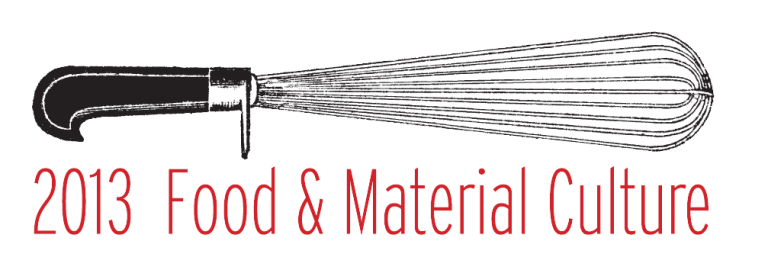
Material Culture: A Review of the 2013 Oxford Symposium on Food and Cookery
Dr. Máirtín Mac Con Iomaire
The focus of this year’s Oxford Symposium on Food and Cookery was on the stew stove but not the stew; the knives and not the meat; the salt pots or ‘nefs’ rather than the salt; the ‘chasen’ not the tea; the plates (whether pewter, ceramic, delftware, china, silver or gold) but not their food content.
Joan Smith discussed the ephemeral nature of food in contrast to art, echoing Barbara Wheaton’s lament that libraries and archival collections often ignore or discard what is commonest and most used. Darra Goldstein spoke of the transformative power of objects. Anthropologist Amy Trubek also underlined the ephemeral nature of food and cooking, pointing out that tradition and practices are constantly disappearing, citing the introduction of the ‘Bimbi’ food processor to the Italian home kitchen as life-changing.
David Sutton spoke of the development of table-manners as a result of the fear of being stabbed by one’s dining neighbour, which led to the development of less sharp table knives with rounder edges. In China, he continued fear of violence towards the Emperor led to the replacement of knives with chopsticks, resulting in the practice of presenting food in smaller bite-size pieces which led, in turn, to a change in the anatomical structure of the denizens of China, a change that did not occur in Europeans until the early modern period, when the use of forks became popular first in Italy and Byzantium and gradually throughout the courts of Europe.
Joan Fitzpatrick discussed the emerging distinction between napkins (literally little cloths) and handkerchiefs (literally hand cloths) during the early modern period, and their use to connote distinctions in manners, femininity and food, while the gradual use of forks, which kept the fingers clean, coincided with the publication of etiquette manuals. Another point of table etiquette in the early modern period included never discussing the food served, a rule blatantly ignored in Oxford this July during the various meals served over the weekend, which included Ethiopian, Brazilian and Middle Eastern repasts, not to forget Stevie Parle’s spice feast on the Friday evening, when guests were encouraged to create their own spice mixes with pestle and mortar.
Joan Smith discussed the ephemeral nature of food in contrast to art, echoing Barbara Wheaton’s lament that libraries and archival collections often ignore or discard what is commonest and most used. Darra Goldstein spoke of the transformative power of objects. Anthropologist Amy Trubek also underlined the ephemeral nature of food and cooking, pointing out that tradition and practices are constantly disappearing, citing the introduction of the ‘Bimbi’ food processor to the Italian home kitchen as life-changing.
Artefacts presented and discussed ranged from Len Fisher’s simple ‘spurtle’ for stirring porridge to Carolin Young’s fabulous visual presentation of silver tureens shaped like boars’ heads and other fantasies. Subjects ranged from Mongolian milk spoons, Belgian beer glasses, Indian thali dishes, James Bond cocktail shakers, New York refrigerators, Italian food processors and 3D food printers; from picnic baskets to the New York City’s Automat; from First World War Trench Fare to Turkish Coffee; from Baghdad kitchens to how kitchen knives have become the new ‘bling’; from coconut scrapers to Bovril; from how to make solar cooking global to elite consumption trends in Georgian Ireland; from Korean folk potters to a prize-winning paper on pottery in prehistoric Oxfordshire; from sugar sculptures in Italian court banquets to equipment used by street food vendors in Istanbul; from visual evidence of table manners to tin boxes for mooncakes, cow creamers and ‘cudsters’; from magical Brazilian cookery pots to the Talmudic ‘qederah’.
Meanwhile, as supplier to the highest echelons of modernist restaurants, Jeremy Medley discussed and demonstrated anti-griddles (salt plate dipped in liquid nitrogen), mini crystal teapots, lavendar spray, lolllipop-kits and bean-tins whose contents is actually candyfloss, indicating that in a world of iPhones, tweeting and blogging, the art of conversation is already being replaced by the 21st century’s version of the medieval soteltie.
While Bee Wilson had already asked us in her introductory discussion to consider the spork – a dual-function spoon and fork or ‘jointed tool’ similar in concept to the camera-phone – another tool discussed by Ken Albala was the ‘nork’, a dual-purpose knife and fork which has proved very practical for people who have lost a limb. However, since the industrial food sector is now designing products which require no utensils whatsoever. This, says Albala, may well result in the loss by an entire generation of the manual dexterity required for the manipulation of all eating-utensils, plastic or otherwise, rendering them superfluous.
All this and a great deal more will be available in printed form from Prospect Books at our Symposium in July, 2014.
